A Comprehensive Study of Agricultural Drought Resistance and Background Drought Levels in Five Main Grain-Producing Regions of China
Abstract
:1. Introduction
2. Materials and Methods
2.1. Data Sources
- (1)
- Meteorological data: The meteorological data were obtained from China’s ground climate daily record dataset from 1982 to 2011 (including the average daily pressure, daily average wind speed, daily maximum temperature, daily minimum temperature, hours of sunshine, daily average relative humidity, etc.). We selected 583 sites with integrated time series for our study.
- (2)
- Crop distribution data: Based on Chinese vegetation distribution vector data with a scale of 1 to 1,000,000 for the year 2000 provided by the Data Sharing Infrastructure of Earth System Science, combined with relevant research results [51], we extracted the spatial distribution of spring wheat, winter wheat, maize, early rice and late rice in the five main grain-producing areas of the country.
- (3)
- Physical data: The content of clay particles was obtained from a Chinese soil characteristics dataset provided by the Environmental and Ecological Science Data Center in Western China of the National Natural Science Foundation of China (NSFC, Beijing, China; http://westdc.westgis.ac.cn).
- (4)
- Socioeconomic data: The socioeconomic data were retrieved from statistical yearbooks of various provinces and cities, the Rural Statistical Yearbook, China’s Regional Economic Statistical Yearbook published by the National Statistics Department in 2011 and national economic and social development statistical bulletins of various provinces and cities in 2010 issued by the China Statistical Information Network. Specific data included the area of cultivated land; the effective irrigation area; the planting area of rice, wheat, maize, soybean, cotton, oil crops, vegetables and other major crops; the total power of agricultural machinery; expenditures on forestry and water conservancy; and GDP per capita.
2.2. Research Methods
2.2.1. Analysis of Agricultural Drought Degree Based on Crops
2.2.2. Assessment of Agricultural Drought Resistance
2.2.3. Evaluation of Integrated Drought Resistance against the Background of Agricultural Drought
2.2.4. Sensitivity Analysis for Evaluation Results
3. Results
3.1. Comprehensive Analysis of Agricultural Drought Degree
3.2. Evaluation of Agricultural Drought Resistance
3.3. Analysis of Comprehensive Drought Resistance Based on Background Agricultural Drought Levels
3.4. Sensitivity Analysis for Integrated Drought Resistance
4. Discussion
4.1. Discussion on the Agricultural Drought Degree
4.2. The Characteristics and Management Strategy of Agricultural Drought Resistance in Different Regions
4.3. Method of Comprehensive Drought Resistance
5. Conclusions
Acknowledgments
Author Contributions
Conflicts of Interest
References
- Wilhelmi, O.V.; Wilhite, D.A. Assessing vulnerability to agricultural drought: A Nebraska case study. Nat. Hazards 2002, 25, 37–58. [Google Scholar] [CrossRef]
- Quiring, S.M.; Papakryiakou, T.N. An evaluation of agricultural drought indices for the Canadian prairies. Agric. For. Meteorol. 2003, 118, 49–62. [Google Scholar] [CrossRef]
- Jiang, G.Q.; Yu, F.L.; Zhao, Y. An analysis of vulnerability to agricultural drought in China using the expand grey relation analysis method. Proced. Engin. 2012, 28, 670–676. [Google Scholar]
- Ni, S.H.; Gu, Y.; Wang, H.R. Study on frangibility zoning of agricultural drought in China. Adv. Water Sci. 2005, 16, 705–709. [Google Scholar]
- Linsley, R.K.; Kohler, M.A.; Paulhus, J.L. Applied Hydrology; McGraw-Hill: New York, NY, USA, 1949. [Google Scholar]
- Palmer, W.C. Meteorologic Drought. Available online: https://www.ncdc.noaa.gov/temp-and-precip/drought/docs/palmer.pdf (accessed on 30 March 2016).
- Food and Agricultural Organisation of United Nations. FAO Report of FAO-CRIDA Expert Group Consultation on Farming System and Best Practices for Drought-Prone Areas of Asia and the Pacific Region; Central Research, Institute for Dryland Agriculture: Hyderabad, India, 2002. [Google Scholar]
- World Meteorological Organization (WMO). Report on Drought and Countries Affected by Drought During 1974–1985; WMO: Geneva, Country, 1986; p. 118. [Google Scholar]
- UN Secretariat General. United Nations Convention to Combat Drought and Desertification in Countries Experiencing Serious Droughts and/or Desertification, Particularly in Africa. Available online: http://www.unccd.int/Lists/SiteDocumentLibrary/conventionText/conv-eng.pdf (accessed on 30 March 2016).
- Professional Standard of the People’s Republic of China. In Disaster Level of Wheat Drought Beijing; China Meteorological Administration: Beijing, China, 2007.
- Zhao, L.; Feng, B.; Zhang, S. Advance in the study on drought and drought index at home and abroad. Jiangsu Agric. Sci. 2012, 40, 345–348. (In Chinese) [Google Scholar]
- Mishra, A.K.; Singh, V.P. A review of drought concepts. J. Hydrol. 2010, 391, 202–216. [Google Scholar] [CrossRef]
- Mishra, A.K.; Singh, V.P. Drought modeling—A review. J. Hydrol. 2011, 403, 157–175. [Google Scholar] [CrossRef]
- Bian, C.; Huang, Y.; Shen, S.; Meng, Y. The drought model indexed by the soil moisture deficiency. Hydrology 2000, 20, 5–10. [Google Scholar]
- Sun, P.; Zhang, Q.; Bai, Y.G.; Zhang, J.H.; Deng, X.Y.; Liu, J.Y. Transitional behaviors of hydrometeorological droughts in Xinjiang using the Markov chain model. Geogr. Res. 2014, 33, 1647–1657. (In Chinese) [Google Scholar]
- Xu, J.; Yang, D. New model for drought estimation and prediction based on distributed hydrological simulation. J. Hydraul. Eng. 2010, 41, 739–747. [Google Scholar]
- Liu, W.; Negron-Juarez, R.I. ENSO drought onset prediction in northeast Brazil using NDVI. Rem. Sens. 2001, 22, 3483–3501. [Google Scholar] [CrossRef]
- Modarres, R. Streamflow drought time series forecasting. Stoch. Environ. Res. Risk Assess. 2007, 21, 223–233. [Google Scholar] [CrossRef]
- Han, P.; Wang, P.; Zhang, S.; Zhu, D. Drought forecasting based on the remote sensing data using ARIMA models. Math. Comput. Model. 2010, 51, 1398–1403. [Google Scholar] [CrossRef]
- Mishra, A.K.; Singh, V.P. Analysis of drought severity-area-frequency curves using a general circulation model and scenario uncertainty. J. Geoph. Res. Atmos. 2009. [Google Scholar] [CrossRef]
- Tase, N. Area-Deficit-Intensity Characteristics of Droughts. Available online: https://dspace.library.colostate.edu/bitstream/handle/10217/61848/HydrologyPapers_n87.pdf?sequence=1&isAllowed=y (accessed on 30 March 2016).
- Hallack-Alegria, M.; Watkins, D.W., Jr. Annual and warm season drought intensity-duration-frequency analysis for Sonora, Mexico. J. Clim. 2007, 20, 1897–1909. [Google Scholar] [CrossRef]
- McVicar, T.R.; Jupp, D.L. The current and potential operational uses of remote sensing to aid decisions on drought exceptional circumstances in Australia: a review. Agric. Syst. 1998, 57, 399–468. [Google Scholar] [CrossRef]
- Moradkhani, H. Hydrologic remote sensing and land surface data assimilation. Sensors 2008, 8, 2986–3004. [Google Scholar] [CrossRef]
- Van Dijk, A.I.J.M.; Renzullo, L.J. Water resource monitoring systems and the role of satellite observations. Hydrol. Earth Syst. Sci. 2011, 15, 39–55. [Google Scholar] [CrossRef]
- Li, H.; Dai, S.; Hu, S.; Tian, G.; Luo, H.X. Comprehensive monitoring model for agricultural drought and its application based on spatial information. Trans. CSAE 2012, 28, 181–188. (In Chinese) [Google Scholar]
- Liu, X.; Zhu, X.; Pan, Y.; Li, S.; Liu, Y. Agricultural drought monitor: Progress, challenges and prospect. Acta Geogr. Sin. 2015, 70, 1835–1848. (In Chinese) [Google Scholar]
- Tan, D.; Liu, L.; Yan, J.; Hu, Y. Research on drought monitoring model based on MODIS data. J. Yangtze River Sci. Res. Inst. 2004, 21, 11–15. (In Chinese) [Google Scholar]
- Xu, K.; Xu, X.; Li, A.; Yang, D. Assessing agricultural drought disaster risk in Chengde city using stochastic method. Trans. CSAE 2013, 29, 139–146. (In Chinese) [Google Scholar]
- Wang, C.; Wang, S.; Huo, Z.; Guo, J.; Li, Y. Progress in research of agro-meteorological disasters in China in recent decade. Acta Meteorol. Sin. 2005, 63, 659–671. (In Chinese) [Google Scholar]
- Liu, G.; Guo, A.; An, S. Research progress in Palmer drought severity index and it’s application. J. Natl. Disaster 2004, 13, 21–27. (In Chinese) [Google Scholar]
- Wu, P.; Zhao, X. Impact of climate change on agricultural water use and grain production in China. Trans. CSAE 2010, 26, 1–6. (In Chinese) [Google Scholar]
- Agnew, C. Using the SPI to identify drought. Drought 2000, 12, 29–42. [Google Scholar]
- Bonaccorso, B.; Bordi, I.; Cancelliere, A.; Rossi, G.; Sutera, A. Spatial variability of drought: an analysis of the SPI in Sicily. Water Res. Manag. 2003, 17, 273–296. [Google Scholar] [CrossRef]
- Ma, J.; Xu, Y.; Pan, J. Drought tendency based on standardized precipitation index (SPI) and relative moisture index over Northeast China from May to September during 1961–2009. J. Meteorol. Environ. 2012, 28, 90–95. (In Chinese) [Google Scholar]
- Kang, X.; Li, C.; Dai, L. Risk assessment of drought for winter wheat production in Hebei Province. Agric. Res. Arid Areas 2012, 30, 232–237. (In Chinese) [Google Scholar]
- Qi, S.; Zhang, X.; Sun, Y.; Li, D.; Li, Q.; Wang, M. Studies on the influence and countermeasures of drought and occurrence rule in wheat sowing time in Huaibei Area. Chin. Agric. Sci. Bull. 2012, 28, 46–53. (In Chinese) [Google Scholar]
- Li, J.; Yue, Y.; Lei, Y.; Wang, Z.; Wang, J. Spatial and temporal pattern of Huanghuaihai winter wheat meteorological drought risk based on SPI. In Proceedings of The 5th National Risk Annual Meeting (RAC-2012), Nanjing, China, 27–28 October 2012. (In Chinese)
- Li, S.; Liu, R.; Ma, Z. Impact of climate change on planting distribution of winter wheat in Shaanxi Province. Agric. Res. Arid Areas 2012, 30, 252–256. (In Chinese) [Google Scholar]
- Kang, X.; Li, C.; Ma, H.; Le, Z. Study on drought evaluation model of winter wheat based on crop water production function. Chin. Agric. Sci. Bull. 2011, 27, 274–279. (In Chinese) [Google Scholar]
- Sun, H.; Su, Z.; Qu, Y. Dynamic assessment of agricultural drought disasters risk based on crop growth model. Agric. Res. Arid Areas 2013, 31, 231–236. (In Chinese) [Google Scholar]
- Zhang, J.; Zhao, Y.; Wang, C.; Yang, X.; Wang, J. Evaluation technology on drought disaster to yields of winter wheat based on WOFOST crop growth model. Acta Ecol. Sin. 2013, 33, 1762–1769. (In Chinese) [Google Scholar] [CrossRef]
- Yan, L.; Zhang, J.; Wang, C.; Yan, D.; Liu, X.; Tong, Z. Vulnerability evaluation and regionalization of drought disaster risk of maize in Northwestern Liaoning Province. Chin. J. Eco Agric. 2012, 20, 788–794. (In Chinese) [Google Scholar] [CrossRef]
- Shang, Y.; Huang, D.; Yang, J. Diagnosis and assessment of agricultural drought system’s vulnerability in irrigated area-Taking Xingtai County of Hebei Province as an example. Areal Res. Dev. 2006, 25, 117–121. (In Chinese) [Google Scholar]
- Shang, Y.; Chen, J.; Zhang, R.; Li, M.; Zhou, F.; Shang, H. Assessment framework and method of agricultural system resilience to drought-A case study of Xingtai City, Hebei Province. Chin. J. Eco Agric. 2011, 19, 167–171. (In Chinese) [Google Scholar] [CrossRef]
- Gu, Y.; Ni, S.; Wang, H. Comprehensive evaluation on ability of coping with agriculture drought in China. Adv. Water Sci. 2005, 16, 700–704. (In Chinese) [Google Scholar]
- Zhang, D.; Wang, G.; Zhou, H. Assessment on agricultural drought risk based on variable fuzzy sets model. Chin. Geogr. Sci. 2011, 21, 167–175. (In Chinese) [Google Scholar] [CrossRef]
- Liu, L.; Liu, S.; Liu, P.; Tian, Y. Synthtic analysis and quantitative estimation of the agricultural vulnerability to drought disaster in Hunan Province. J. Natl. Disaster 2002, 1, 78–83. (In Chinese) [Google Scholar]
- Yang, Q.; Feng, F.; Chao, L. Comprehensive evaluation on ability of coping with agriculture drought by using multi-objective decision. J. Catastr. 2007, 22, 5–8. (In Chinese) [Google Scholar]
- Planting Industry Management Department, The ministry of agriculture of the People’s Republic of China. Available online: http://www.zzys.moa.gov.cn (accessed on 7 April 2016).
- Chad, M.; Ramankutty, N.; Foley, J.A. Geographic distribution of crop areas, yields, physiological types, and net primary production in the year 2000. Glob. Biogeochem. Cycl. 2008, 22, 71–86. [Google Scholar]
- Yang, Z.; Liu, L.; Cao, Y.; Yu, Y.; Yan, D. Advances in risk assessment and forecast warning of agricultural drought disasters. J. Econ. Water Res. 2011, 29, 12–17. [Google Scholar]
- Ni, G.; Li, X.; Cong, Z. Temporal and spatial characteristics of reference evapotranspiration in China. Trans. CSAE 2006, 22, 1–4. (In Chinese) [Google Scholar]
- Li, Y.; Cui, J.; Zhang, T. Comparative study on calculation methods of reference evapotranspiration. J. Desert Res. 2002, 22, 372–376. (In Chinese) [Google Scholar]
- Lv, H.; Qian, S.; Yang, F. Estimation of actural evaptranspiration for maize field in north China. J. Appl. Meteorol. Sci. 2003, 14, 722–728. [Google Scholar]
- Zhang, F.; Wang, D.; Qiu, B. China’s Agricultural Phenology Atlas; Science Press: Beijing, China, 1987. [Google Scholar]
- Allen, R.G.; Pereira, L.S.; Raes, D. Crop Evapotranspiration: Guidelines for Computing Crop Water Requirement; Food and Agriculture Organization of the United Nations (FAO) Irrigation and Drainage Paper No. 56; FAO: Rome, Italy, 1998. [Google Scholar]
- He, B. Quantitative Assessment and Spatial Characters Analysis of the Risk to Agricultural Drought in China; Institute of Geographic Sciences and Natural Resources Research, Chinese Academy of Sciences: Beijing, China, 2010. (In Chinese) [Google Scholar]
- Chen, L.; Fang, L.; Li, S. Study on drought trend of crop growing season in Northeast China in recent 50 years. J. Catastr. 2010, 25, 5–10. (In Chinese) [Google Scholar]
- General Administration of Quality Supervision, Standardization Administration of the People’s Republic of China. Classification of meteorological drought GB/T 2048006; General Administration of Quality Supervision, Standardization Administration of the People’s Republic of China: Beijing, China, 2006.
- Liu, L.; Yang, Z.; Xu, Z. Risk assessment of agricultural drought disaster in Liaoning Province. Water Res. Power 2013, 31, 1–4. (In Chinese) [Google Scholar]
- Zhang, Y. Evaluation on the Ecological Suitability of Urban Construction Land based on Weights Sensitivity Analysis for Junshan District of Yueyang City. Master’s Thesis, Hunan University, Changsha, China, 2012. [Google Scholar]
- Chen, Y.; Yu, J.; Khan, S. Spatial sensitivity analysis of multi-criteria weights in GIS-based land suitability evaluation. Environ. Model. Softw. 2010, 25, 1582–1591. (In Chinese) [Google Scholar] [CrossRef]
- Wang, H.; Gong, Q. Analysis of rainfall anomaly in growing season of crops in Northeast China. Meteorol. Sci. Technol. 2005, 33, 345–349. (In Chinese) [Google Scholar]
- Wang, Y.; Huang, Y.; Zhang, W. Variation and tendency of surface aridity index from 1960 to 2005 in three provinces of Northeast China. Adv. Earth Sci. 2008, 23, 619–627. (In Chinese) [Google Scholar]
- Yan, L. A study on Dynamic Risk Assessment of Maize Drought Disaster in Northwestern Liaoning Province. Master’s Thesis, Northeast Normal University, Changchun, China, 2012. [Google Scholar]
- Wang, Z.; He, F.; Li, J. Assessment on drought risk of typical wheat in China based on EPIC model. Agric. Res. Arid Areas 2012, 30, 210–215. (In Chinese) [Google Scholar]
- Zhao, L.; Wu, J.; Lv, A. Spatial and temporal analysis of drought over the Huang-Huai-Hai Plain and its surroundings based on the standardized precipitation index. Res. Sci. 2011, 33, 468–476. (In Chinese) [Google Scholar]
- Li, S.; Lv, H.; Zhang, Y. Spatial-temporal distribution characteristics of dryness/wetness over Huanghuaihai region from 1961 to 2006. Meteorol. Sci. Technol. 2008, 36, 601–605. (In Chinese) [Google Scholar]
- Lv, H.; Yang, F.; Qian, S. Study on water consumption in summer corn field under condition of drought. Meteorol. Month. 2002, 28, 38–41. (In Chinese) [Google Scholar]
- Zhang, H.; Qu, Y. Preliminary discuss on the drought mitigation strategy for the five provinces in the middle and lower reaches of the Yangtze River. Chin. Water Res. 2011, 13, 31–34. (In Chinese) [Google Scholar]
- Wang, W.; Cai, X. Analysis on variation feature of drought in mid-and lower-reaches of Yangtze River Basin. Plateau Meteorol. 2010, 29, 1587–1593. (In Chinese) [Google Scholar]
- Zhang, S.; Hou, M.; Wang, S. The drought assessment of Sichuan Basin based on information diffusion and the fuzzy comprehensive evaluation method. J. Nat. Res. 2008, 23, 713–723. (In Chinese) [Google Scholar]
- Zhuang, G.; Fei, Y.; Liu, C.; Yan, M.; Wang, J. Adaptation between irrigation intensity and ground water carrying capacity in North China Plain. Trans. CSAE 2013, 29, 1–10. (In Chinese) [Google Scholar]
- Yang, R.; Xiao, B.; Chen, Y.; Lu, B. The background of high efficiency utilization of agricultural climatic resources in Huang-Huai-Hai Plain and the main farming techniques. J. Arid Land Res. Environ. 2010, 24, 88–93. (In Chinese) [Google Scholar]
- Ma, X.; Yao, Y.; Xu, Y. A model for dynamic assessment of crop yield losses from drought and its tryout in Anhui Province. J. Catastr. 2010, 25, 13–17. (In Chinese) [Google Scholar]
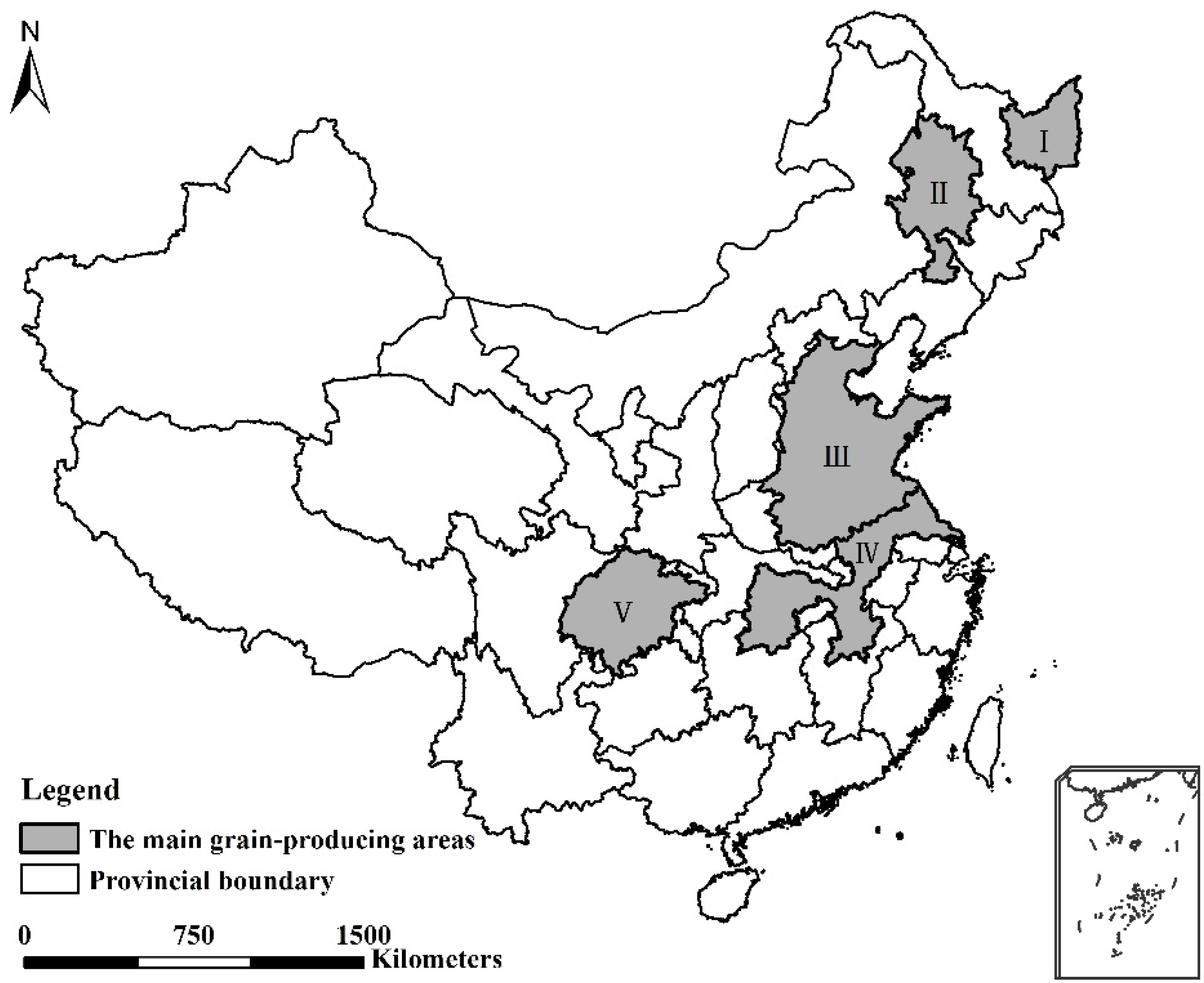
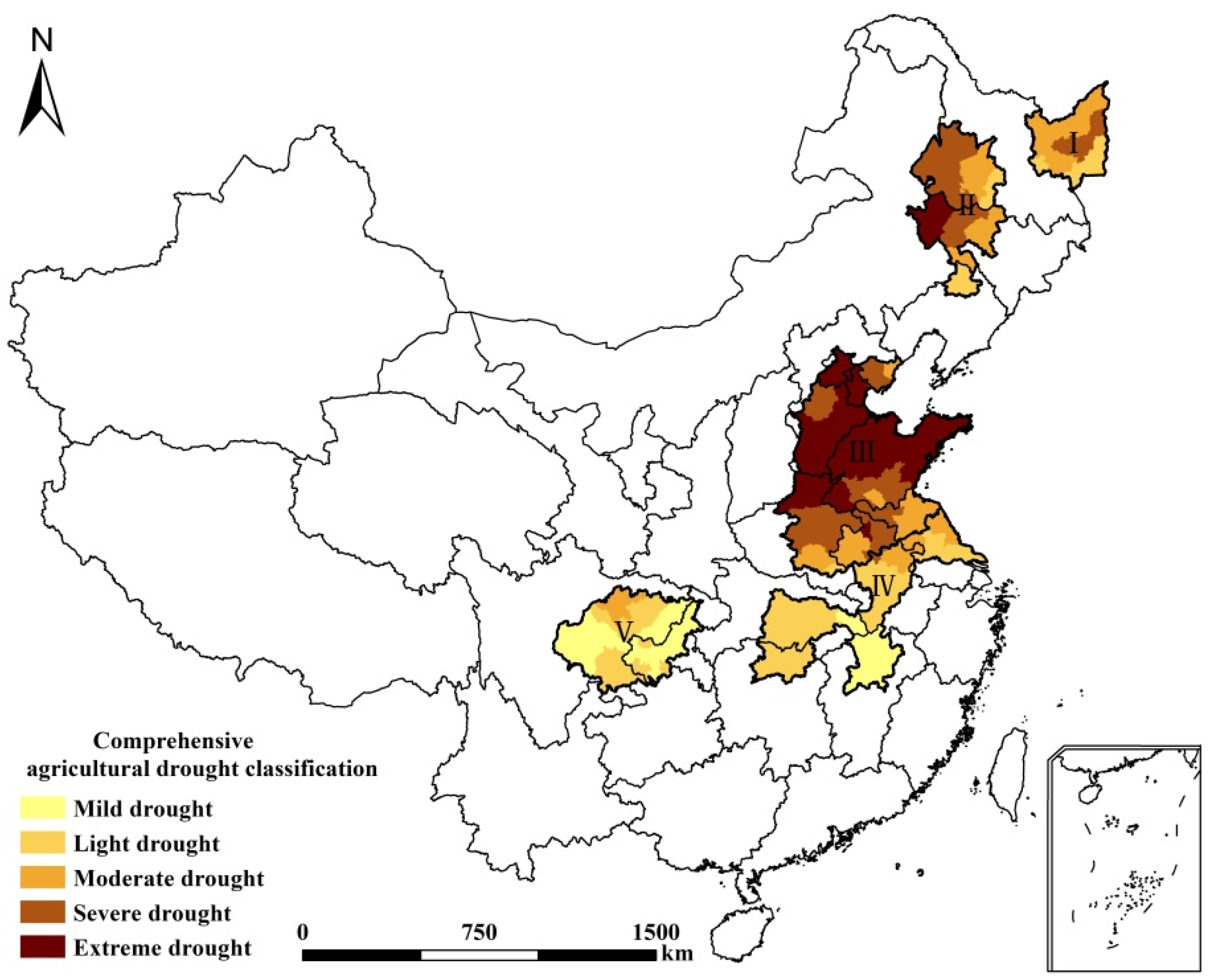
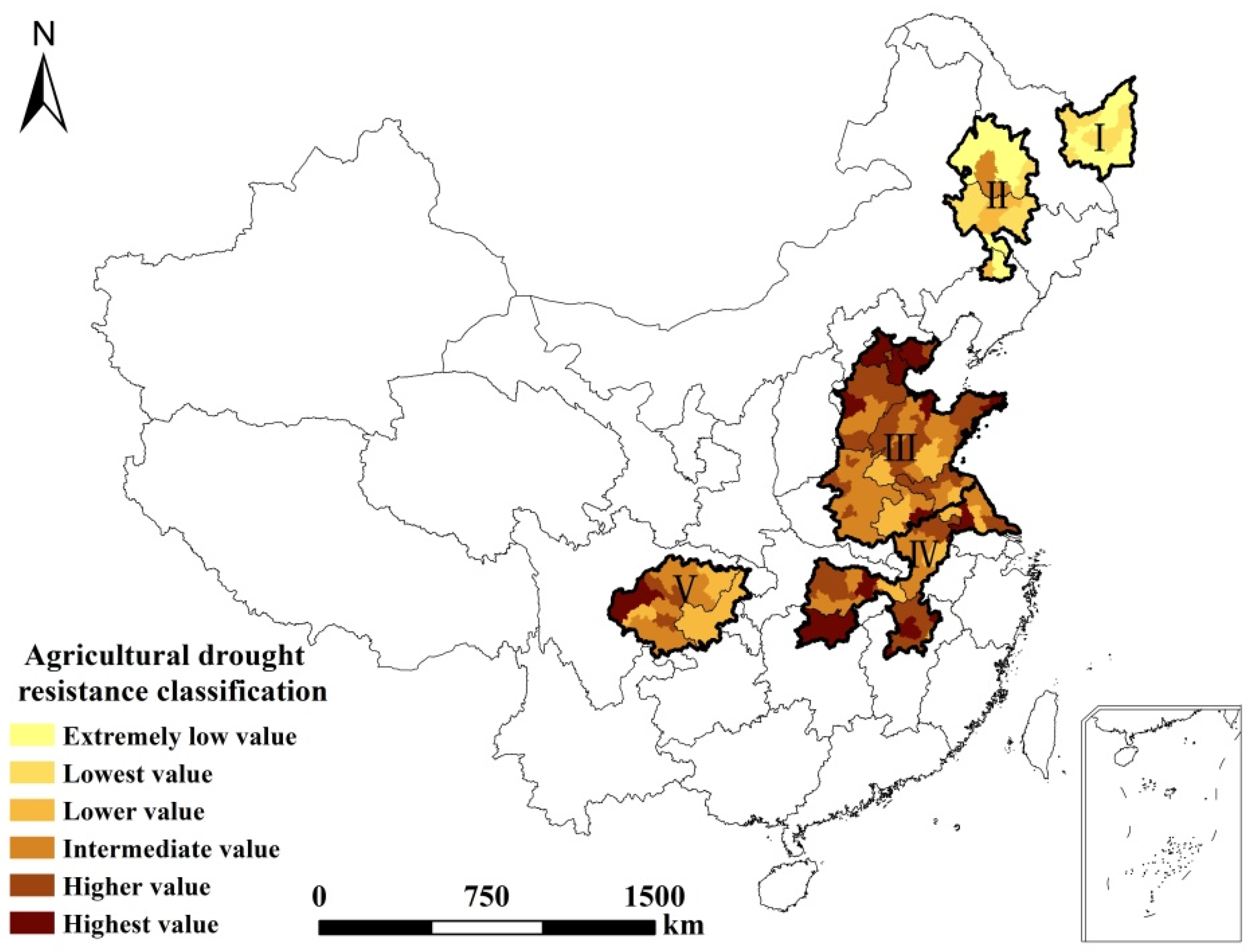

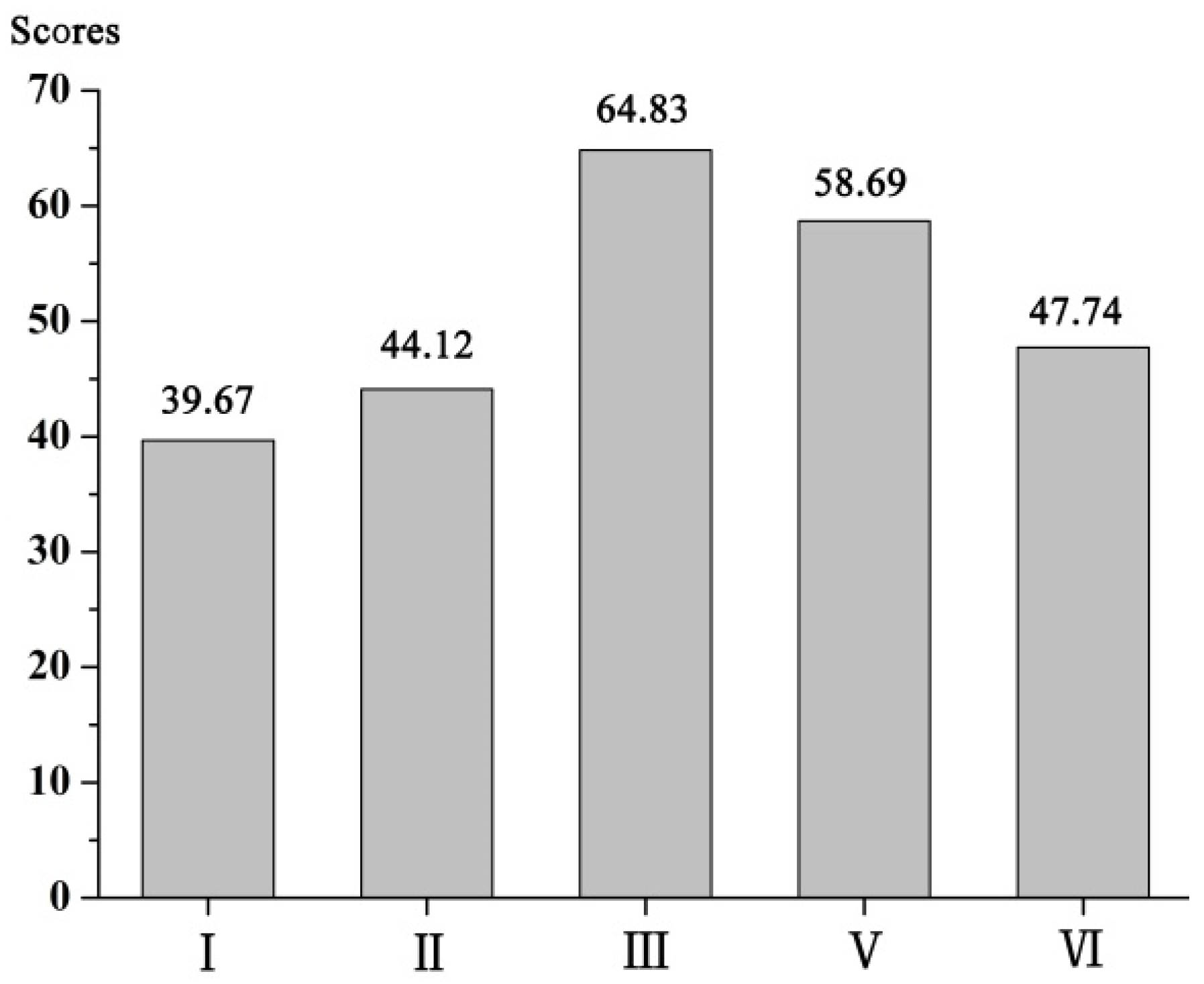
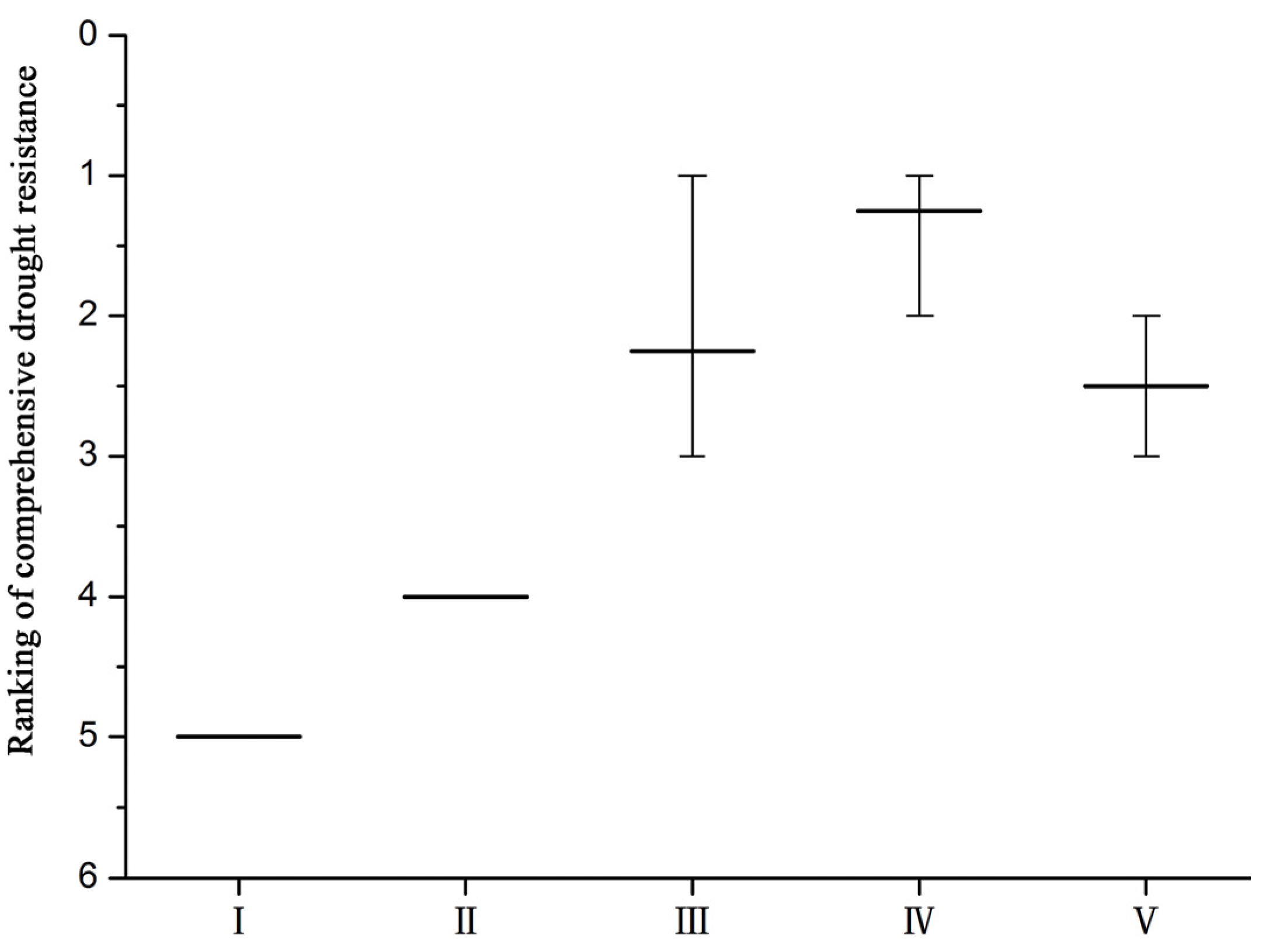
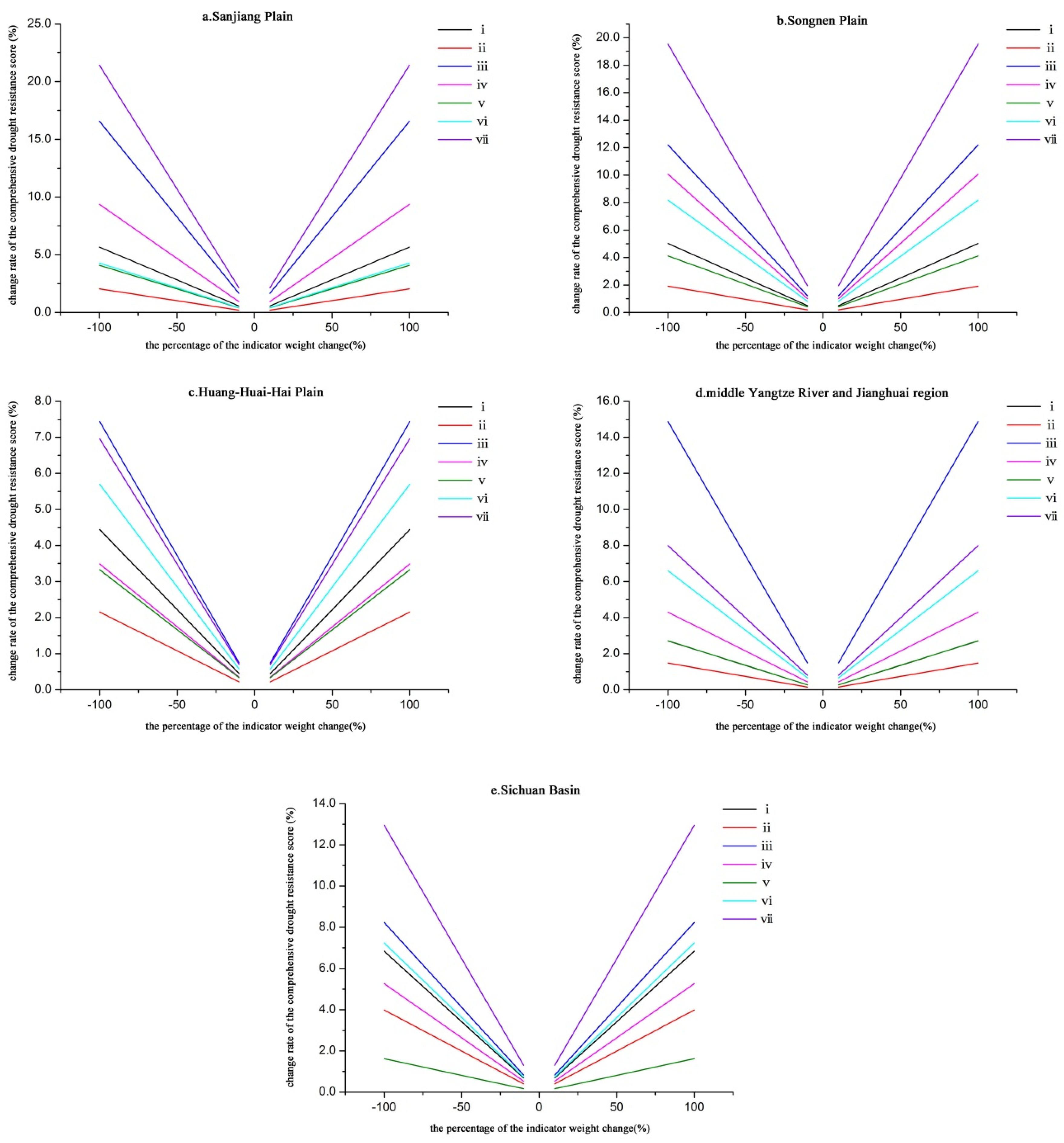
| Aridity Index (AI) | <0.5 | 0.5 to 0.8 | 0.8 to 1.0 | 1.0 to 1.6 | 1.6 to 1.8 | >1.8 |
|---|---|---|---|---|---|---|
| Dry grade | 1 | 2 | 3 | 4 | 5 | 6 |
| Drought degree | No drought | Mild drought | Light drought | Moderate drought | Severe drought | Extreme drought |
| Weight index (Mi) | 0 | 1.5 | 3 | 6 | 12 | 24 |
| Assessment Target | Indicators | Index Calculation | Index Interpretation |
|---|---|---|---|
| agriculture drought resistance | soil texture | The soil texture is divided into sandy soil, sandy loam, light loam, medium loam, heavy loam and clay, according to clay content in the soil layer of 0 to 30 cm | The sandy soil is weak at storing water with poorer drought resistance. Clay soil can save a lot of water, but it also has poor drought resistance with low water infiltration and heavy loss. Loam soil has strong drought resistance due to the great capability of preserving water and nutrients. |
| area ratio of high and low water consumption crops | The ratio of water-intensive crops area and low water-demand crops area | The higher the value is, the greater are the regional planting water demand and irrigation pressure; thus, the agriculture drought resistance is relatively weaker. | |
| rate of efficient irrigation | The ratio of effective irrigation area and arable land area | The higher the value, the higher the degree of regional irrigation and the stronger the agriculture drought resistance. | |
| agricultural machinery dynamic coefficient | The ratio of total agricultural machinery power and arable land | The higher the value, the more the agricultural inputs, the higher the agricultural mechanization degree and the stronger the agriculture drought resistance. | |
| expenditure of agroforestry and water transaction | Directly obtained from the yearbook | The higher the value, the better improved is the agricultural production condition, which is more conducive to enhance the agriculture drought resistance. | |
| per capita GDP | The ratio of regional GDP and population | The higher the value, the higher the level of social economic development, the greater the drought control and engineering construction investment and the stronger the agriculture drought resistance. |
| Main Grain Producing Area | Mild Drought | Light Drought | Moderate Drought | Severe Drought | Extreme Drought |
|---|---|---|---|---|---|
| Sanjiang Plain | 0.00 | 24.74 | 53.33 | 21.93 | 0.00 |
| Songnen Plain | 0.00 | 13.42 | 28.22 | 44.80 | 13.56 |
| Huang-Huai-Hai Plain | 0.00 | 0.72 | 15.40 | 29.98 | 53.90 |
| Yangzi River and Jianghuai Plain | 21.24 | 65.28 | 12.67 | 0.82 | 0.00 |
| Sichuan Basin | 55.72 | 34.98 | 9.30 | 0.00 | 0.00 |
| Main Grain Producing Area | Lowest Value | Lower Value | Medium Value | Higher Value | Highest Value |
|---|---|---|---|---|---|
| Sanjiang Plain | 58.92 | 41.08 | 0.00 | 0.00 | 0.00 |
| Songnen Plain | 56.04 | 21.51 | 22.45 | 0.00 | 0.00 |
| Huang-Huai-Hai Plain | 0.00 | 10.74 | 20.57 | 35.54 | 33.15 |
| Yangzi River and Jianghuai Plain | 0.00 | 18.64 | 39.01 | 34.06 | 8.29 |
| Sichuan Basin | 10.92 | 57.72 | 21.58 | 9.78 | 0.00 |
| All_Index | Del_ADI | Del_Soil | Del_Crop | Del_Irrig | Del_Power | Del_AFW | DEL_GDP | |
|---|---|---|---|---|---|---|---|---|
| Ⅰ | 5 | 5 | 5 | 5 | 5 | 5 | 5 | 5 |
| Ⅱ | 4 | 4 | 4 | 4 | 4 | 4 | 4 | 4 |
| Ⅲ | 2 | 3 | 1 | 1 | 3 | 3 | 2 | 3 |
| Ⅳ | 1 | 1 | 2 | 2 | 1 | 1 | 1 | 1 |
| Ⅴ | 3 | 2 | 3 | 3 | 2 | 2 | 3 | 2 |
| Main Grain Producing Area | Lowest Value | Lower Value | Medium Value | Higher Value | Highest Value |
|---|---|---|---|---|---|
| Sanjiang Plain | 85.46 | 14.54 | 0.00 | 0.00 | 0.00 |
| Songnen Plain | 61.61 | 15.94 | 22.45 | 0.00 | 0.00 |
| Huang-Huai-Hai Plain | 1.98 | 9.10 | 17.19 | 42.08 | 29.65 |
| Yangzi River and Jianghuai Plain | 0.00 | 26.46 | 31.19 | 30.19 | 12.16 |
| Sichuan Basin | 38.20 | 33.08 | 19.77 | 8.94 | 0.00 |
© 2016 by the authors; licensee MDPI, Basel, Switzerland. This article is an open access article distributed under the terms and conditions of the Creative Commons by Attribution (CC-BY) license (http://creativecommons.org/licenses/by/4.0/).
Share and Cite
Kang, L.; Zhang, H. A Comprehensive Study of Agricultural Drought Resistance and Background Drought Levels in Five Main Grain-Producing Regions of China. Sustainability 2016, 8, 346. https://doi.org/10.3390/su8040346
Kang L, Zhang H. A Comprehensive Study of Agricultural Drought Resistance and Background Drought Levels in Five Main Grain-Producing Regions of China. Sustainability. 2016; 8(4):346. https://doi.org/10.3390/su8040346
Chicago/Turabian StyleKang, Lei, and Hongqi Zhang. 2016. "A Comprehensive Study of Agricultural Drought Resistance and Background Drought Levels in Five Main Grain-Producing Regions of China" Sustainability 8, no. 4: 346. https://doi.org/10.3390/su8040346
APA StyleKang, L., & Zhang, H. (2016). A Comprehensive Study of Agricultural Drought Resistance and Background Drought Levels in Five Main Grain-Producing Regions of China. Sustainability, 8(4), 346. https://doi.org/10.3390/su8040346





